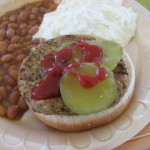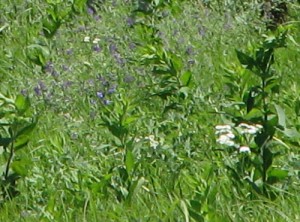What do you think of when you think of Kansas beef? The old Kansas City Stock Yards? The feed lots? Old Dodge City? You might, but to be in touch with contemporary food, you probably should think about ranches and packing plants, too. That’s because beef in Kansas is huge. Kansas may be the Wheat State or the Sunflower State, but it could very well be the Beef State, and plenty of Kansans, I suspect, don’t have any idea about it.
 Those who do know, however, have to include the thousands who’ve attended the Symphony in the Flint Hills at one time or another. I went to this hugely popular event last weekend, and the importance of the cattle industry to this part of the world was evident. Cowboys and cowgirls kept sentinel as visitors arrived in the afternoon at the location just outside Council Grove. (I’m hoping the map will give you some sense of the terrain if my camera doesn’t.) They moved some cattle around, too.
Those who do know, however, have to include the thousands who’ve attended the Symphony in the Flint Hills at one time or another. I went to this hugely popular event last weekend, and the importance of the cattle industry to this part of the world was evident. Cowboys and cowgirls kept sentinel as visitors arrived in the afternoon at the location just outside Council Grove. (I’m hoping the map will give you some sense of the terrain if my camera doesn’t.) They moved some cattle around, too.
Although developing good will and educating the public about the beef industry isn’t part of the Symphony in the Flint Hills’ mission, the event wouldn’t occur without the ranchers, because they own nearly all of this marvelous Flint Hills landscape, the biggest stretch of tallgrass prairie in the world. A nice thing about the symphony event is that is is preceded by presentations on prairie wildlife, ranching, American Indians, pioneer history and other related topics.
Hays House dinner, prairie supper
 Midday meals in the country still are dinners, as far as I know, and the lighter evening meal is supper. In that tradition, we had dinner at the Hays House. It prepared us for a stroll through Council Grove and the 3/4-mile walk from the parking area to the concert site, with several calories left over. I can’t remember the last time I had fried chicken but it was really good. The mashed potatoes and gravy were fine though not memorable, the salad was generic, and the rolls had some whole grain. Dessert (bread pudding) was beside the point.
Midday meals in the country still are dinners, as far as I know, and the lighter evening meal is supper. In that tradition, we had dinner at the Hays House. It prepared us for a stroll through Council Grove and the 3/4-mile walk from the parking area to the concert site, with several calories left over. I can’t remember the last time I had fried chicken but it was really good. The mashed potatoes and gravy were fine though not memorable, the salad was generic, and the rolls had some whole grain. Dessert (bread pudding) was beside the point.
Supper was served at the concert site. A small army of volunteers fed the horde with little waiting. The menu: pulled pork, shredded brisket or veggie burger plus choice of two sides from among potato salad, pasta salad, cole slaw and baked beans. I had the veggie burger, as I didn’t think I was ready for a meat sandwich so soon after dinner, but it wasn’t very good. Those who had the other sandwiches rated them as delicious. The sides were, well, typical American fare, and I’ll leave it at that.
Music fills the air
 The featured event, the concert, began shortly after 6:30 p.m. Although the skies were clear (two days after a nearby tornado) and the temperature comfortable in the shade, the sun sizzled. Most nevertheless suffered the sun gladly during the concert. The program leaned toward a pops sensibility, and during its course some of those roving cowpunchers moved a herd of cattle, about 150 head I’m guessing, into view of the crowd. When the orchestra hit a familiar cattle theme (sorry I can’t recall which), the riders got those cattle running a short distance to the delight of the crowd.
The featured event, the concert, began shortly after 6:30 p.m. Although the skies were clear (two days after a nearby tornado) and the temperature comfortable in the shade, the sun sizzled. Most nevertheless suffered the sun gladly during the concert. The program leaned toward a pops sensibility, and during its course some of those roving cowpunchers moved a herd of cattle, about 150 head I’m guessing, into view of the crowd. When the orchestra hit a familiar cattle theme (sorry I can’t recall which), the riders got those cattle running a short distance to the delight of the crowd.
Somebody nearby commented, “That’s a lot of hamburger,” and indeed it was. I’m guessing this ranch is a cow-calf operation, which breeds cows and raises calves until they’re ready to be finished at one of those feedlots several months later.
This area is perfect for raising cattle. The rocky, thin soil isn’t good for crops, and the bison did well on it for years. These prairies do better in terms of plant and animal diversity when properly grazed, and I hope you can see from the photos that those prairies aren’t a sea of grass, grass and more grass.
To eat beef
The Flint Hills may be one reason I eat beef. I see this landscape, and I think the cattle belong there in the absence of the decimated bison. I wish that most cattle didn’t end up in feedlots, and maybe that method of fattening cattle will wane under the current corn and fuel prices.
I’ve struggled to arrive at some conclusion on how I feel about the Symphony on the Prairie, but my effort gets mixed in with thoughts about preserving the prairie ecosystem and about the unsustainable state of our agriculture system. I guess I’ll stay ambivalent. Still, I’m glad I went. I just don’t know if I’ll do it again.
Addendum: I uploaded more photos to flickr at http://www.flickr.com/photos/foodperson/sets/72157605727685973/. Since I’d formatted them for the blog, they are fairly small, still, they’re there if you’re interested.




Bill Smith // Jun 21, 2008 at 1:40 pm
What a great set of stories about the real world of the Kansas Flint Hills! Thanks for sharing!
Dr. Bill ;-)
Personal Blog: http://flinthillsofkansas.blogspot.com/
Our 22 county Flint Hills Tourism Coalition, Inc. promotes experiential tourism visits to the Kansas Flint Hills – the website is: http://www.kansasflinthills.travel/
If you like Kansas beef, try TALLGRASS BEEF COMPANY. They are headquartered in Sedan, KS and specialize in grass fed/finished beef free of hormones, antibiotics, chemicals. One of the producing ranches for Tallgrass is the Red Buffalo Ranch (owned by Kansan and journalist Bill Kurtis). His ranch is at the southern edge of the Flint Hills and he is a major proponent of the Flint Hills region of Kansas. His latest book THE PRAIRIE TABLE COOKBOOK is a great look at food in the 19th century and today in the west, lots of photos in the book from the Flint Hills region of KS! If you want to see about the book, go to my web link and look for the Prairie Table items in the header!
Enjoy,
Michelle Martin
Janet Majure // Jun 22, 2008 at 10:36 am
Thanks, Bill!
Michelle, you shouldn’t be so modest and not mention you’re Kurtis’s co-author! I haven’t tried Tallgrass Beef Co. meat; it’s unfortunately out of my price range, but I’m lucky to be able to get more modestly price, grassfed/finished beef locally. Still, it’s a great resource for people who aren’t able to find local producers.